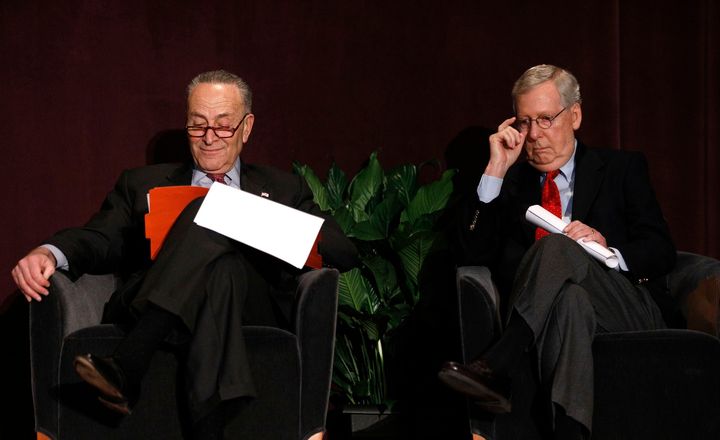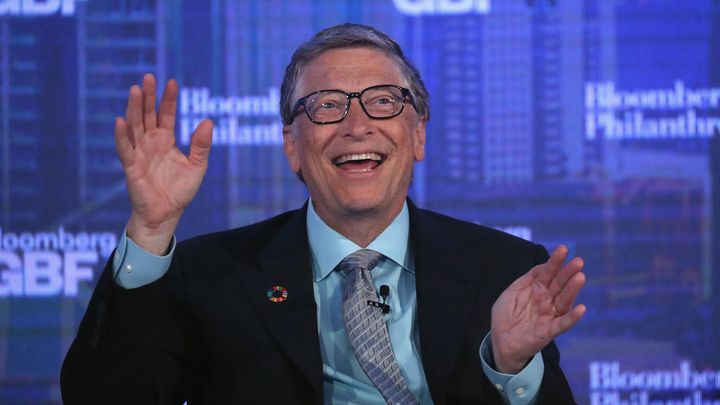Ahead of the 2018 midterm elections, former House Speaker Paul Ryan (R-Wis.) made a pilgrimage to the Venetian Hotel in Las Vegas to meet with mega-donor Sheldon Adelson about the need for Republicans to preserve their congressional majority.
After presenting the GOP’s plans alongside officials from the Congressional Leadership Fund (CLF), the House Republican-aligned super PAC, Ryan simply stepped out of the room. Norm Coleman, the former Minnesota senator who co-founded CLF in 2011 and was the group’s first chair, then made the ask to Adelson, closing what ended up to be a $30 million infusion—an amount around 100 times greater than what Ryan would be legally allowed to receive in contributions to national party committee accounts.
PACs that don’t donate to or coordinate with campaigns are legally allowed to solicit donations of any amount—with their congressional leadership members just on the other side of a door—because the Supreme Court’s 2010 Citizens United ruling set the table for the invention of a new type of political committee that can raise and spend unlimited sums. But while these super PACs must disclose their donors, those donors can in turn be groups that are opaque in their sources of funding, resulting in enormous amounts of “dark money” or “gray money” flowing to groups that work in close concert with House and Senate leaders in both parties.
Through the first half of 2020, the two super PACs affiliated with Democratic congressional leaders have already raised more dark money than in 2018 and previous cycles, with the Senate arm, affiliated with Minority Leader Chuck Schumer (D-N.Y.), showing a particularly marked increase, according to Sludge’s review of data compiled by the Center for Responsive Politics.
On the Republican side, the House arm, through June, has nearly matched the amount of dark money it received in the 2018 election, putting it on pace to far exceed last cycle’s totals. While the Senate GOP’s dark-money intake lags behind last cycle’s, its super PAC is sitting on the most cash of the four groups, with $97 million in the bank, including a fresh $25 million donation from Sheldon and Miriam Adelson in June.
The trend of increasing amounts of dark money to congressional leadership super PACs has implications not just for voters, for whom it is impossible to know the original source of funding behind campaign ads barraging TV and social media in the months to come. Mega-donations from wealthy patrons to House and Senate leaders’ dark-money-powered campaign vehicles open an avenue for opaque influence over what bills emerge from Congress and have a chance to become public policy. The federal legislative process has become increasingly top-down and centralized over the past two decades, with the same congressional leaders who solicit big checks for their aligned super PACs also appointing the chairs of key committees that act as gatekeepers, or graveyards, for bills.
Shortly after the 2018 midterms, a freshperson Republican House member, Mike Gallagher, who represents Wisconsin’s Eight Congressional District in the area around Green Bay, published a tell-all about the degree to which congressional leadership controls which bills are advanced out of committees.
“Leadership determines which bills come to the floor for a vote, leadership chooses loyal committee chairs so as to ensure that bills opposed by special interests will be killed in committee, and in the event that problematic amendments do make it to the House floor, the Rules Committee—an organ of the speaker—kills them off,” Rep. Gallagher wrote. “The legislation that does pass tends to come in last-second omnibus bills that legislators have no chance to read, let alone debate and amend. The dirty secret is that many House members like this arrangement because it prevents them from having to cast tough votes.”
The four major super PACs affiliated with Democratic and Republican congressional leadership in the House and Senate have together raised $378.2 million this election cycle through June, according to totals from the National Institute on Money in Politics. As of July 21, the four super PACs’ total cash on hand was $294 million, according to the Center for Responsive Politics (CRP), much of which will shortly flood the television airwaves. According to a report this week by CRP’s Anna Massoglia, these four super PACs have already pushed out $116 million in digital ads, TV “issue ads” that skirt independent expenditure disclosure laws by avoiding expressly advocating for a candidate’s election or defeat, and contributions to 2020 campaigns.
In 2018, the CLF’s ads on behalf of Ryan’s Republican successor in Wisconsin’s First Congressional District were notably anti-immigrant, consistent with findings from the Wesleyan Media Project that Republican ads in the midterms were more negative and focused on immigration.
The Schumer-aligned Senate Majority Project (SMP) has benefited from by far the largest increase in the amount of dark money received this cycle, with $8 million coming in from Majority Forward, a non-disclosing 501(c)(4) organization whose website says it is affiliated with SMP. The Senate Democatic leader’s super PAC has also received $8.5 million from the “gray money” Democracy PAC, a group that has received $46 million from the Fund for Policy Reform, another non-disclosing nonprofit.
The SMP’s $16.5 million in non-transparent money from Majority Forward and Democracy PAC makes up over 16% of its total raised this cycle and is a 7x increase over its dark money intake in the 2018 cycle, when SMP received $1.1 million from Majority Forward and $1.245 million from Red And Gold PAC, a non-disclosing group that popped up to spend in the Arizona Republican primary for Senate that year. Prior to 2018, significant donors to SMP in 2016 and 2012 were transparent, with one exception in 2014: $1 million from HFNWA LLC, a company managed by Franklin L. Haney, a longtime Democratic donor and real estate mogul.
The Nancy Pelosi-aligned super PAC, House Majority PAC, has taken in $1.6 million in dark money from House Majority Forward, its affiliated non-disclosing c4, and $2.5 million from Democracy PAC. This total is well over twice as much as the $1.825 million in dark money it accepted in the 2018 cycle, entirely from Patriot Majority USA, a 501(c)(4) that was reported in the 2014 cycle to have received donations from labor unions and a nursing association.
The super PAC aligned with Republican House Leader Kevin McCarthy, the Congressional Leadership Fund, has received $19.9 million this cycle through June from the American Action Network (AAN), a non-disclosing 501(c)(4) organization. AAN was co-founded by Norm Coleman in 2010, who was its original CEO and now serves as its chair. This amount of dark money puts CLF in position over the next few months to blow past the $23.5 million it hauled in from AAN last cycle, both amounts far above the $420,594 it received in 2016 and the $482,759 it got in 2014’s cycle.
The leadership super PAC sitting on the biggest war chest, the McConnell-aligned Senate Leadership Fund (SLF), received $7.6 million this cycle from its affiliated non-disclosing nonprofit, One Nation. This amount through the first half of 2020 is behind the $18.55 million SLF received in the 2018 cycle and $21.7 million in 2016, but One Nation has already spent $16.6 million on ads this cycle for Republican Senate candidates out of its dark money vault. SLF has raised a total $101.2 million this cycle through June, behind the SMP’s $147.1 million but ahead of the House Majority Project’s $68.4 million and CLF’s $61.5 million, with the highest share of the four—84%—coming from donors giving $1 million or more, according to the Campaign Finance Institute.
On the rise in dark money to the super PACs of congressional leaders, Michael J. Malbin, the director of the Campaign Finance Institute, a division of the National Institute on Money in Politics, told Sludge, “Political party leaders used to boast about the transparency of party money. I guess not so much if you count these party offshoots.”
Last month, the non-partisan, non-profit Campaign Legal Center (CLC) released StopSecretSpending, a new transparency resource for the public to better understand how wealthy special interests influence elections through TV ads, largely bought by super PACs like these four associated with congressional leaders. Among the solutions CLC highlights is a requirement that super PAC campaign ads feature backing groups’ top three donors in a disclaimer, and requiring conduit organizations to track the sources of their large donations.
These provisions are pillars of the DISCLOSE Act, a bill with a decade of congressional history, that was re-introduced in the Senate last April as S.1147 by Sen. Sheldon Whitehouse (D-R.I.) and in the House by Rep. David Cicilline (D-R.I.) as H.R. 2977. By requiring prompt disclosure of donors giving $10,000 or more during an election cycle, combined with several other measures to enhance transparency around conduit organizations, the DISCLOSE Act would enable voters to know the true funding source behind campaign ads blanketing the airwaves.
The DISCLOSE Act was incorporated into H.R. 1, House Democrats’ ethics and campaign finance reform package, which passed the chamber in March 2019 by a vote of 234 to 193 but is unlikely to be taken up by the Republican-controlled Senate under McConnell. Sen. Whitehouse’s latest version of the bill was referred in April to the Senate Committee on Rules and Administration, which is chaired by Sen. Roy Blunt (R-Mo.). On its reintroduction last April, Sen. Whitehouse said in a press release, “On issues from climate change to gun safety, a torrent of dark money spending has for too long prevented Congress from pursuing solutions that are overwhelmingly supported by the public.”
After the Supreme Court’s January 2010 decision in Citizens United sparked the need for greater disclosure of the secret funding sources behind outside spending groups, the Democratic-controlled House took up the bill and passed it in June by a vote of 219–206. But in September, the bill was filibustered for the second time in three months by Senate Republicans, including Sen. Susan Collins of Maine, and while it has been reintroduced every session since, the bill has not been passed by Congress. The fateful procedural vote was 59-39, one vote short of the 60 needed to pass the filibuster, with Republican Sen. Scott Brown of Massachusetts standing with his party. Brown had won the January 19, 2010 special election for Senate after the death of Sen. Ted Kennedy, defeating Democratic nominee Attorney General Martha Coakley with 52% of the vote to Coakley’s 47%.



